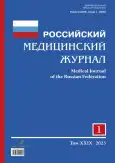Complex rehabilitation of children and adolescents with dysfunction of the sacroiliac joints
- Authors: Zadorina-Negoda G.N.1, Novoselova I.N.1,2
-
Affiliations:
- Clinical and Research Institute of Emergency Pediatric Surgery and Trauma
- Russian Medical Academy of Continuous Professional Education
- Issue: Vol 29, No 1 (2023)
- Pages: 17-28
- Section: Original Research Articles
- Submitted: 29.01.2023
- Accepted: 08.02.2023
- Published: 23.02.2023
- URL: https://medjrf.com/0869-2106/article/view/159373
- DOI: https://doi.org/10.17816/medjrf159373
- ID: 159373
Cite item
Abstract
BACKGROUND: Back pain (BP) is encountered by physicians in many specialties. Sacroiliac joint (SIJ) dysfunction is one of the most common causes of non-specific BP (NBP). Many approaches have been accepted for the treatment of this pathology, including drug correction, physiotherapy, therapeutic blockade, and manual therapy (MT). In most cases, these methods help reduce the severity of the pain syndrome and restore the physiological mobility of the SIJ. Despite ongoing therapy, BP persists in some cases. The most likely reason for the ineffectiveness of MT is impaired muscle balance. The correction of this impairment is carried out with the help of other rehabilitation techniques.
AIM: To develop a comprehensive program for the rehabilitation of patients with NBP associated with SIJ dysfunction.
MATERIALS AND METHODS: A prospective study included 54 patients aged 7–18 years who complained of pain in the lumbosacral spine. The patients were divided into two groups: the first group underwent manual correction of dysfunction, followed by mechanotherapy on block simulators, and the second group underwent correction of articular dysfunction using specially selected movements performed asymmetrically depending on the identified disorders, and the therapeutic gymnastics program included mechanotherapy and postural workout. At all stages of rehabilitation treatment according to the progression system, training for muscle control was carried out. According to indications, all children underwent mild MT.
RESULTS: A dynamic step-by-step system for assessing the biomechanics of movements and tonic–phasic balance has been developed. A technique for the rehabilitation treatment of NBP with concomitant SIJ dysfunction has been developed, which was selected individually depending on the identified disorders and features of motor activity.
CONCLUSION: The proposed rehabilitation system simplifies and systematizes work in patients who complained of BP associated with osteoarticular dysfunction. The effectiveness of rehabilitation increased due to the precisely selected methods, depending on the root cause of NBP associated with acute or recurrent SIJ dysfunction. A rehabilitation technique aimed at preventing recurrent SIJ dysfunctions helps prevent relapses of BP and minimize the risk of developing articular pathology of the lower extremities.
Full Text
About the authors
Galina N. Zadorina-Negoda
Clinical and Research Institute of Emergency Pediatric Surgery and Trauma
Author for correspondence.
Email: galinazadorina@gmail.com
ORCID iD: 0000-0002-0869-4591
SPIN-code: 9504-9352
research associate
Russian Federation, MoscowIrina N. Novoselova
Clinical and Research Institute of Emergency Pediatric Surgery and Trauma; Russian Medical Academy of Continuous Professional Education
Email: i.n.novoselova@gmail.com
ORCID iD: 0000-0003-2258-2913
SPIN-code: 1406-1334
MD, Dr. Sci. (Med.)
Russian Federation, Moscow; MoscowReferences
- Isajkin AI, Akarachkova ES, Isajkina OJu, i dr. Bol’ v spine. Klinicheskie rekomendacii. Saint Petersburg: OOO «Skifija-print»; 2021. 80 p. (In Russ).
- Srinivasalu H, Sikora KA, Colbert RA. Recent updates in juvenile spondyloarthritis. Rheum Dis Clin North Am. 2021;47(4):565–583. doi: 10.1016/j.rdc.2021.07.001
- Achar S, Yamanaka J. Back pain in children and adolescents. Am Fam Physician. 2020;102(1):19–28.
- Cucchiaro G, Francis C, Householder K, Fernandez A. Sacroiliac joint pain in adolescents: diagnostic and treatment challenges. Paediatr Neonatal Pain. 2022;4(2):87–91. doi: 10.1002/pne2.12080
- Shavlovskaya OA, Gordeeva IE, Ansarov KSh, Prokofyeva YuS. Chronic pain syndrome in diseases of periarticular tissues. S.S. Korsakov Journal of Neurology and Psychiatry. 2020;120(3): 109–118. (In Russ). doi: 10.17116/jnevro2020120031109
- Prather H, Bonnete M, Hunt D. Nonoperative treatment options for patients with sacroiliac joint pain. Int J Spine Surg. 2020; 14(suppl. 1):35–40. doi: 10.14444/6082
- Vanelderen P, Szadek K, Cohen SP, et al. Sacroiliac joint pain. Pain Pract. 2010;10(5):470–478. doi: 10.1111/j.1533-2500.2010.00394.x
- Frosch M, Leinwather S, Bielack S, et al. Treatment of unspecific back pain in children and adolescents: results of an evidence-based interdisciplinary guideline. Children (Basel). 2022;9(3):417. doi: 10.3390/children9030417
- Stahlschmidt L. Epidemiology of chronic pain in children and adolescents. In: Dobe M, Zernikow B, editors. Practical treatment options for chronic pain in children and adolescents. Springer; 2019. P. 3–6.
- King S, Chambers CT, Huguet A, et al. The epidemiology of chronic pain in children and adolescents revisited: a systematic review. Pain. 2011;152(12):2729–2738. doi: 10.1016/j.pain.2011.07.016
- Parfenov VA. Causes of lower back pain. Russian Neurological Journal. 2019;24(5):14–20. (In Russ). doi: 10.30629/2658-7947-2019-24-5-14-20
- Parfenov VA, Yakhno NN, Kukushkin ML, et al. Acute nonspecific (musculoskeletal) low back pain Guidelines of the Russian Society for the Study of Pain (RSSP). Neurology, Neuropsychiatry, Psychosomatics. 2018;10(2):4–11. (In Russ).
- Evans R, Haas M, Schulz C, et al. Spinal manipulation and exercise for low back pain in adolescents: a randomized trial. Pain. 2018;159(7):1297–1307. doi: 10.1097/j.pain.0000000000001211
- Yarikov AV, Morev AV, Shpagin MV, Fraerman AP. Sacroiliac joint syndrome: aetiology, clinical presentation diagnosis and management. Annals of clinical and experimental neurology. 2019; 13(2):60–68. (In Russ). doi: 10.25692/ACEN.2019.2.7
Supplementary files















